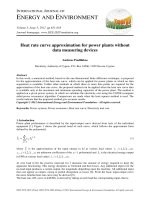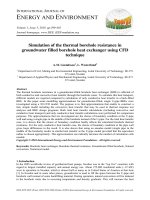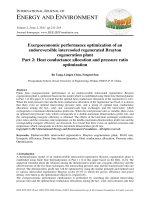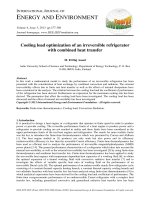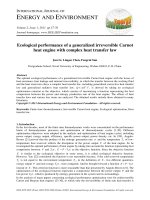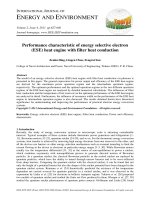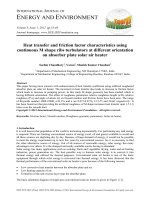Heat tranfer
Bạn đang xem bản rút gọn của tài liệu. Xem và tải ngay bản đầy đủ của tài liệu tại đây (715.88 KB, 8 trang )
Proceedings World Geothermal Congress 2015
Melbourne, Australia, 19-25 April 2015
The Analytical Solution of the Water-Rock Heat Transfer Coefficient and Sensitivity
Analyses of Parameters
Guowei Zhang, Jialing Zhu, Jun Li and Qiulin Wang
Key Laboratory of Efficient Utilization of Low and Medium Grade Energy of Ministry of Education, Tianjin University, Tianjin
300072, China
Keywords: EGS, single fracture, heat transfer coefficient, analytical solution, sensitivity analysis, correlation equation
ABSTRACT
Most previous works with respect to Enhanced Geothermal Systems (EGS) applied local thermal equilibrium method to study
water-rock heat transfer. In order to use the local thermal non-equilibrium method that is close to actual condition, for the single
fracture model, water-rock heat transfer coefficient analytical solutions are deduced using the energy balance. For the parameters
related to the calculation, except the inner surface temperature, all the parameters can be obtained easily, but the inner surface
temperature is necessary to the heat transfer coefficient. In one semi-circle section, by 2D heat conduction the heat fluxes from the
inner surface and the inner surface temperature can be calculated, so the analytical solution of heat transfer coefficient is given.
Then the measureable parameters from the reference are substituted into the solution and calculate heat transfer coefficient.
Comparing the results with the reference, almost all the relative errors are less than 30%, and it shows that this method is
receivable. At the conditions of four different outer surface temperatures, sensitivity analyses about two main parameters (flow
velocity and aperture) are completed, and it indicates that the heat transfer coefficient is more sensitive to the flow velocity, but less
to the aperture. Finally, for water-rock laminar heat convection model, the correlation equation is given, which is indicates the
importance of Prandtl number to heat transfer.
1. INTRODUCTION
EGS involves many kinds of subjects, such as heat transfer, flow mechanics and rock mechanics. At present, theoretical
studies and engineering studies are two major ways. Especially, for theoretical studies, numerical simulations are dominated, which
can obtain the results easily for different temperature gradient, heat reservoir dimension, geological conditions.
The fluid-rock (fracture) heat transfer is significant to study EGS. To deal with heat transfer, there are two scenarios: local
thermal equilibrium and local thermal non-equilibrium [1]. The former considers that fluid-rock heat transfer is finished
instantaneously and fluid temperature is same as rock temperature, which is widely applied to simplify works [2, 3]. The later
viewpoint thinks that temperature difference between fluid and rock exists and two energy equations should be used to describe
heat transfer in the fluid and in the rock [1, 4, 5]. Generally, the local thermal equilibrium method leads to inaccurate estimation for
heat extraction [6]. If the fracture spacing is more than 2-3m then local thermal equilibrium isn’t a valid assumption [7].
The local thermal non-equilibrium is an actual theory, but it is difficult to analyze than local thermal equilibrium. Using the
local thermal non-equilibrium, some researches have been performed [8-10]. Furthermore, Dong [11] introduced sensitivity analysis to
fluid-rock heat transfer and discussed the affection of several parameters on temperature filed of the rock.
For the local thermal non-equilibrium method, heat transfer coefficient is an important parameter, which is useful to determine
temperature flied or total heat exchange amount. The last work about heat transfer coefficient can be traced to 1993 [12]. Hence, at
this study, the calculation of the heat transfer coefficient is focused again. By the energy balance, the analytical solution of the heat
transfer coefficient is deduced and sensitivity analyses of two parameters (flow velocity and aperture) are done. In addition, for
water-rock laminar heat convection model, the correlation equation is given.
2. MODEL DESCRIPTION
2.1 Physical model
The geometry of the water-rock heat transfer model is a cylinder with a single fracture and the fracture runs along the Zdirection (Fig.1, the fracture is exaggerated). Fluid flows from one side to another in the fracture and heat transfer with the hot
matrix. Because of removing the heat from the rock to the fluid, the inner surface temperature (the fracture surface temperature)
decreases. The outer surface temperature of the model is constant, and the temperature difference between inner and outer surfaces
leads to heat conduction. Overall, the heat conducted from the matrix is equal to the heat removed by fluid from the fracture
surfaces; it is also equal to the heat convected.
1
Zhang, Zhu, Li and Wang.
Fig.1 Physical model of water-rock heat transfer with a single fracture
2.2 Mathematic model
For the above physical process, some assumptions are made as follows.
(1) Porosity of the rock is neglected, and the rock is treated as the isotropic material.
(2) The fluid is treated as incompressible liquid and constant physical property. No gasification due to the high pressure.
(3) No consideration the radiation heat transfer.
(4) No consideration the end effect.
(5) No consideration the heat loss.
The length of the cylinder is L , radius r0 . The outer surface temperature is maintained constant T0 . The fluid inlet
temperature and outlet temperature are t1 , t2 respectively, and the fluid flow velocity is u .
Heat removed by fluid through the fracture can be expressed as
Q c p qmt c p qm t2 t1
(1)
where, c p ——the isobaric heat capacity, J ℃ ;
qm ——the fluid mass flow-rate, kg s ;
t ——the temperature difference of fluid, ℃.
Due to flowing, the heat convection exists between the fluid and the rock, and the heat convected is expressed as
Q hAt hA T t
'
i
f
(2)
tf
1
t1 t2
2
(3)
where, h ——the heat convection coefficient, W m2 K ;
A ——the heat convection exchange area, m 2 ;
t ' ——the temperature difference between fluid and inner surface, ℃;
Ti ——the arithmetic meat temperature of the inner surface, ℃;
tf ——the fluid temperature in the fracture, is taken as the arithmetic mean of the inlet and outlet temperatures, ℃.
Because the inner surface temperature isn’t uniform, so it is difficult to calculate the heat conducted. Assume that any point
temperature is the surface average temperature Ti . Only half of the cylinder is studied due to symmetry. (Fig.2)
2
Zhang, Zhu, Li and Wang
Fig.2 Semi-circle section of the model
For the real situations, the boundary conditions are complicated and dynamic. But for the theoretical study, in order to analyze
conduction and convection conveniently, the uniform heat flux and the uniform wall temperature are applied generally [13]. So at
present work, the constant outer surface temperature boundary and adiabatic two end faces boundary are put into use.
Using cylindrical coordinates, the time-independent differential equation of heat conduction and boundary conditions are
written as,
2T
r 2
(4)
1 T 1 2T
0
r r r 2 2
r r0,T T0
0 or π,T Ti
3. SOLUTION OF HEAT TRANSFER COEFFICIENT AND VALIDATION
3.1 Calculation of heat transfer coefficient
By the eq. (1) (2) (3), the heat transfer coefficient can be expressed as
h
cqm t2 t1
t t
A Ti 1 2
2
(5)
The mass flow rate of the fluid qm is calculated as follow
qm u 2r0
(6)
where, u ——the fluid flow velocity, m s ; ——the aperture, m ; r0 ——the radius of the section, m ; ——the density of the
fluid, kg m3 .
Fluid flows in the fracture touching the two rectangular fracture surfaces, so the heat convection exchange area can be given as
A 2 2r0 L
(7)
where, L ——the length of the cylinder, m .
Eqs. (6) and (7) are substituted into eq. (5), and the heat transfer coefficient is rewritten as
h
c pu t2 t1
(8)
t t
2 L Ti 1 2
2
From eq. (8), the heat transfer coefficient is a function of many parameters. The isobaric heat capacity and the density are
dependent on the thermal physical property; the length of cylinder lies on the geometry; both the fluid flow velocity, the aperture,
the inlet temperature and the outlet temperature are measureable parameters. They are set or measured easily, but it is difficult to
obtain the inner surface temperature.
Following the analytical method is given to calculate the inner surface temperature.
For eq. (4), the analytical solution of the temperature filed is [14]
2v 1
T Ti
r r
sin 2v 1
4
T0 Ti 0
π
v 0 2v 1
(9)
3
Zhang, Zhu, Li and Wang.
y
Through the transformation of coordinates r x 2 y 2 , arctan , the cylindrical coordinate’s temperature filed is
x
transformed as rectangular coordinate’s
4
T T T T
i
0
i
x 2 y 2 r0
2v 1
2v 1
v 0
y
sin 2v 1 arctan
x
(10)
The heat conducted can be calculated by the integral for temperature filed eq. (10). But there is a singularity at the point
x r0 , y 0 , at which physical significance is unreasonable (two kinds of boundary conditions). So the integral for temperature
filed is done from 0 to 0.99r0 . The heat conducted of the rock from the outer surface to the inner surface is calculated.
Q 4
0.99 r0
0
(
T
) Ldx
y y 0
(11)
where, ——the thermal conductivity, W m K .
Eq. (10) is substituted into eq. (11)
Q
16
r0 L T0 Ti
0.99 r0
0
1
x 2 r02
dx
8
L T0 Ti ln199
42.32
L T0 Ti
(12)
By eq. (1) and eq. (12), the inner surface temperature can be calculated
Ti T0
πc p qm t2 t1
(13)
42.32 L
Eq. (6) is substituted into eq. (13)
Ti T0
πc p r0 u t2 t1
(14)
21.16 L
The inner surface temperature is given, all the parameters are measureable, eq. (14) is substituted into eq. (8)
h
21.16c p u t2 t1
(15)
42.32 LT0 2πc p r0 u t2 t1 21.16 L t1 t2
3.2 Validation
For the experimental tiny scale model, taking into consideration of the experimental rock sample from the reference and rock
triaxial texting system, the granite and water are chosen and the geometric and physical parameters are listed as follows.
L=102 mm , r0 =25.5 mm , c p 4200 J kg ℃ ,
1000 kg m3 , =3.5 W m K .
Above parameters are substituted into the equation (15). The heat transfer coefficient is a function of the flow velocity, the
aperture, the inlet temperature and the outlet temperature.
h
0.31105u t2 t1
(16)
15.10824T0 0.00067u t2 t1 7.55412 t1 t2
where, ——the aperture, μm ;
u ——the fluid flow velocity, mm/s .
Using the experimental parameters from the reference, 78 data are calculated by eq. (16), and the comparison of results is
presented in Fig. 4
4
Zhang, Zhu, Li and Wang
=19.17 μm
=24.66 μm
=26.56 μm
=30.52 μm
80
-1
60
=15.85 μm
=16.44 μm
=16.98 μm
=21.16 μm
-2
-2
h / Wm K
-1
80
100
h / Wm K
100
40
T0=90
60
T0=100
℃
℃
40
20
0
20
0
20
40
60
-1
80
100
20
40
60
80
100
-1
120
140
u / mms
u / mms
100
=14.50 μm
=15.50 μm
=16.54 μm
=18.09 μm
=19.72 μm
240
=11.95 μm
=13.45 μm
=16.72 μm
-1
160
60
-2
h / Wm K
-2
h / Wm K
-1
200
80
120
T0=120
80
40
T0=140
℃
℃
20
40
60
80
100
120
140
-1
160
180
0
200
0
20
40
u / mms
60
80
100
120
140
-1
u / mms
—— Present
work
—— Reference
Fig.3 Comparing the present’s heat transfer coefficients
with the results from the reference
Through the error analysis for 78 data, the minimum relative error is only 0.02%, and almost all the relative errors are less than
30%. Especially, for low flow velocity (less than 100mm/s ), the relative errors aren’t greater than 20%. Just for one data, when the
flow velocity is 203.72mm/s , which seriously exceed the regular velocity for the HDR, the relative error is 43.9%. From above
figure, it indicates that the errors increase with the flow velocity and two groups of results are in good agreement at low flow
velocity.
4. SENSITIVITY ANALYSIS
4.1 Theory
For a system, the system characteristics P is influenced by n parameters, 1, 2 ,3
*
When
1* , 2* ,3*
, n*
, system characteristics is P
*
*
,P f
1* , 2* ,3*
, n*
, n , P f 1, 2 ,3
, n .
. The sensitivity analysis is defined in
order to investigate the trend and level of system characteristics P deviating standard state P* because of parameters ranging,
when every parameter ranges within suitable scope [15].
Dimensionless sensitivity function is defined as
S k
dP k k
d k
P
(17)
when k k* , the sensitivity factor is given as
S * k
dP k
d k
k*
k k*
(18)
P*
Comparing the sensitivity factors, the effect extent of the parameters on the system can be determined. The greater factors, it
shows that slight fluctuation of parameters can influence systems seriously.
4.2 Results
At the different outer surface temperatures, sensitivity analyses are done for two major parameters, flow velocity u and
aperture . The heat transfer coefficient is regarded as system characteristics P , P h f u, . When u u* or * , h h* .
For example, T0 90℃ , inlet temperature t1 40℃ , outlet temperature t2 88℃ , flow velocity ranges from 8.2mm s to
97.75mm s , aperture ranges from 19.17 μm to 30.52 μm , u* =49mm s and * 24.5μm .
5
Zhang, Zhu, Li and Wang.
When u u* =49mm s and * 24.5μm , the functions fitting h h u and h h are shown in Fig.5 respectively.
18
20
22
24
/ μm
26
28
30
32
65
120
h=h(u)
60
h=h()
100
-1
-2
60
45
40
40
20
0
h /Wm K
50
-2
h / Wm K
-1
55
80
35
0
20
40
60
umms
-1
80
100
30
Fig.4 The functions fitting for h h u and h h
Functions fitting h h u and h h are
h u 0.003u 2 0.896u 0.357
h 2.298 5.524
By eq. (17), sensitivity functions are given as
Su
S
0.006u 2 0.896u
(19)
0.003u 2 0.896u 0.357
2.298
2.298 5.524
(20)
By eq. (18), sensitivity factors are given as
Su* 1.133 , S* 1.109
Applying above methods, for the different outer surface temperatures T0 100℃ , T0 120℃ and T0 140℃, the sensitivity
factors are listed in Table 1.
Table 1 Heat transfer coefficient sensitivity factors for the flow velocity and aperture at different outer surface
temperatures
T0 / ℃
u* / mm s-1
100
* / μm
t1 / ℃
t2 / ℃
Su*
S*
70
18.5
57
95
1.108
1.098
120
102
14
62
117
1.140
1.134
140
76
17
73
129
1.094
1.090
For all the outer surface temperatures, comparing sensitivity factors, the results ( Su*>S* ) show that heat transfer coefficient is
affected more by flow velocity than the aperture.
5. CORRELATION EQUATION OF HEAT CONVECTION
By the experimental results, the aperture chose as characteristic length, and Reynolds number and Nusselt number are
calculated. Reynolds number range from 0.31-8.04, so flowing state is laminar. Using software, correlation equation
Nu f ( Re, Pr ) can be given.
The correlation equation Nu CRea Pr b is the basic equation, and taking logarithms for both sides of equation the correlation
equation is changed as lg Nu lg C a lg Re b lg Pr . By the multiple linear regression, the result is
lg Nu 4.06 0.92lg Re 1.89lg Pr , where lg C 4.06, a 0.92, b 1.89 . So for the laminar flow water-rock heat transfer the
correlation equation is Nu 0.000087Re0.92 Pr1.89 (as shown in fig.5)
6
Zhang, Zhu, Li and Wang
1E-3
Nu/Pr
1.89
+20%
1E-4
-20%
1
10
Re
Fig.5 The correlation equation and errors
From fig.5, the relative errors are seen, and about 80% data are in the reasonable range of ±20%. Additional, the power
exponent of Prandtl number is higher than Reynolds number, and it indicates that the influence of fluid viscidity on heat transfer
isn’t insignificant. So the correlation equation Nu f ( Re) can’t be used, which is another usual equation for heat convection.
5. CONCLUSIONS
In this paper, the calculation method of the heat transfer coefficient is mainly emphasized. The inner surface temperature,
which is only one non-measureable parameter, can be calculated and then the heat transfer coefficient be obtained easily. In terms
of experimental parameters from the reference and analytical solution of heat transfer coefficient, 78 data are presented and
compared with the results from the reference. Due to use the different solutions, the results are smaller than reference, and almost
all the relative errors are less than 30%, which indicates that the analytical solution in this work is credible. Moreover, the errors
increase gradually with flow velocity, and there is a good fit for low flow velocity. When flow velocity is below 100mm/s , the
error isn’t greater than 20%. Only for one condition, flow velocity 203.72mm/s , the relative error is 43.9%, but this velocity goes
far beyond the general velocity in EGS.
By sensitivity analysis, for four different outer surface temperatures T0 90℃ T0 100℃ T0 120℃ T0 140℃ , the sensitivity
factors of flow velocity and aperture are 1.133, 1.108, 1.140, 1.094 and 1.109, 1.098, 1.134, 1.090 respectively. This results ( S >S )
demonstrate that flow velocity plays a more important role in determining heat transfer coefficient than aperture.
*
u
*
Finally, the correlation equation Nu 0.000087Re0.92 Pr1.89 is presented. The Power exponent of Prandtl number is higher
than others correlation equations for heat convection in the duct. It shows that the fluid viscidity is an important parameter for heat
convection in this model.
REFERENCES <HEADING 1 STYLE>
[1] Jiang P. X., Ren Z. P.: Numerical investigation of forced convection heat transfer in porous media using a thermal nonequilibrium model, International Journal of Heat and Fluid Flow, 22, (2001), 102-110.
[2] McTigue D. F.: Thermoelastic response of fluid-saturated porous rock, Journal of Geophysical Research, 91, (1986), 9533-9542.
[3] Kurashige M.: A thermoelastic theory of fluid-filled porous materials, International Journal of Solids Structures, 25, (1989),
1039-1052.
[4] Rees D. A. S., Bassom A. P., Siddheshwar P. G.: Local thermal non-equilibrium effects arising from the injection of a hot fluid
into a porous medium, Journal of Fluid Mechanics, 594, (2008), 379-398.
[5] He L. W., Jin Z. H.: A local thermal non-equilibrium poroelastic theory for fluid saturated porous media, Journal of Thermal
Stresses, 33, (2010), 799-813.
[6] Guo J., Chen J. L., Cao W. J., Jiang F. M.: Research Review on Enhanced Geothermal System, Electric Power Construction, 35,
(2014), 10-24.
[7] Sanyal S. K., Granados E. E., Butler S. J., Horne R. N.: An alternative and Modular Approach to Enhanced Geothermal Systems,
World Geothermal Congress 2005, Antalya, Turkey, 2005.
[8] Shaik A. R., Rahmam S. S., Tran N. H., Tran T.: Numerical simulation of Fluid-Rock coupling heat transfer in naturally
fractured geothermal system, Applied Thermal Engineering, 31, (2011), 1600-1606.
[9] Zhao J.: Analytical and experimental studies of heat convection by water flow in rock fractures, The 33th U.S. Symposium on
Rock Mechanics (USRMS) [C], Santa Fe, New Mexico, 1992.
[10] Jiang F. M., Luo L., Chen J. L.: A novel three-dimensional transient model for subsurface heat exchange in enhanced
geothermal systems, International Communication in Heat and Mass Transfer, 41, (2013), 57-62.
[11] Dong H. Z., Luo R. H., Zhang L.: Seapage and heat transfer model of a single fracture of rock and relevant parameter
sensitivity analysis, Journal of Hohai University (Natural Sciences), 41, (2013), 42-47.
7
Zhang, Zhu, Li and Wang.
[12] Zhao J., Tso C. P.: Heat transfer by water flow in rock fractures and the application to Hot Dry Rock geothermal systems,
International Journal of Rock Mechanics and Mining Sciences & Geomechanics Abstracts, 30, (1993), 633-641.
[13] Yang S. M., Tao W. Q.: Heat Transfer, Beijing: Higher Education Press, (2010), 47.
[14] Zhang H. J.: Heat conduction, Beijing: Higher Education Press, (1992),147.
[15] Zhang G., Zhu W. S.: Parameter sensitivity analysis and optimizing for text programs, Rock and Soli Mechanics, 14, (1993),
51-58.
8
